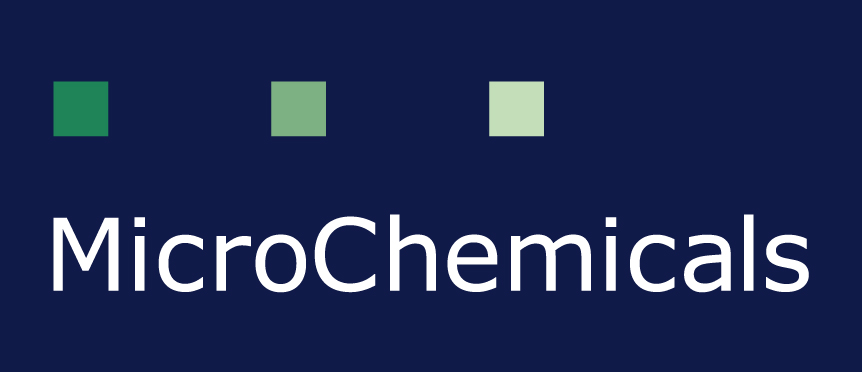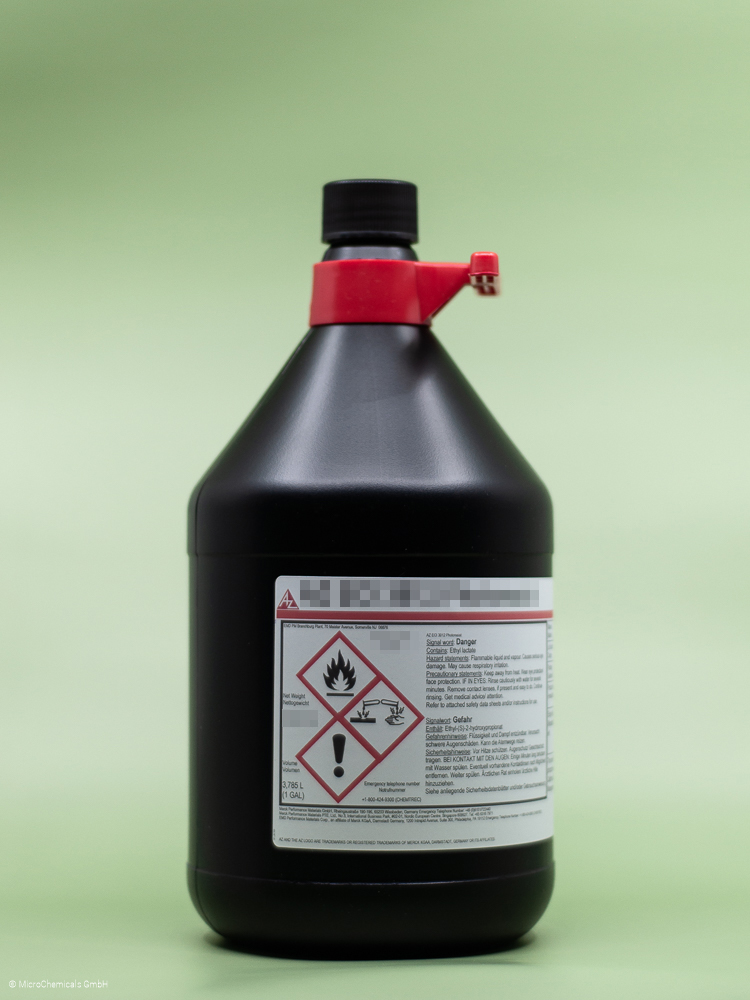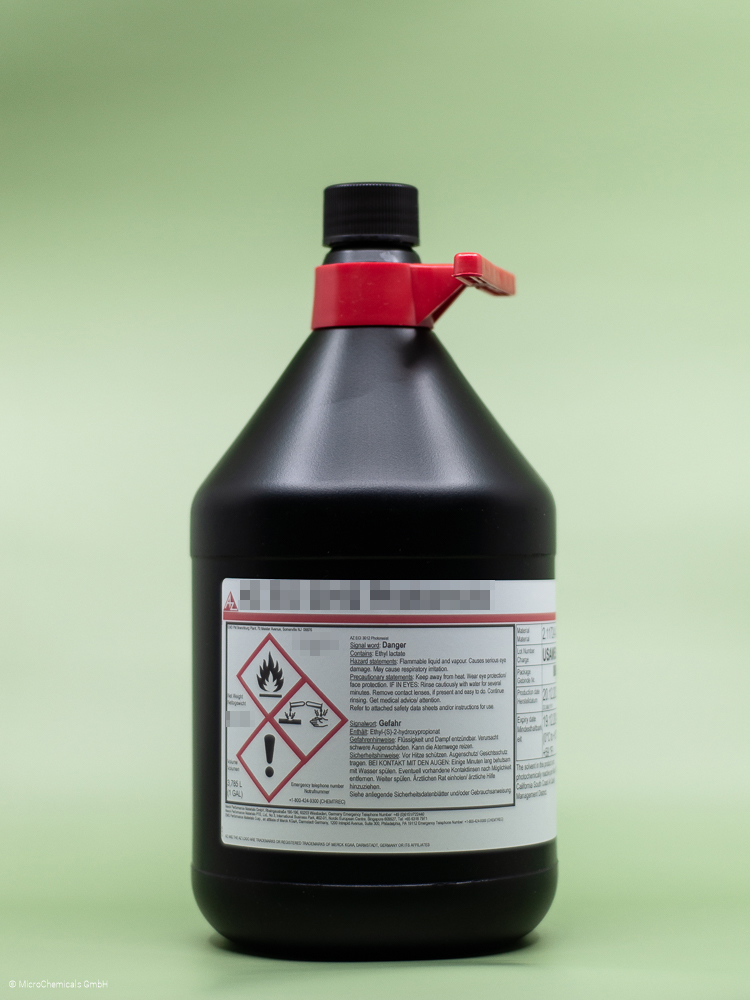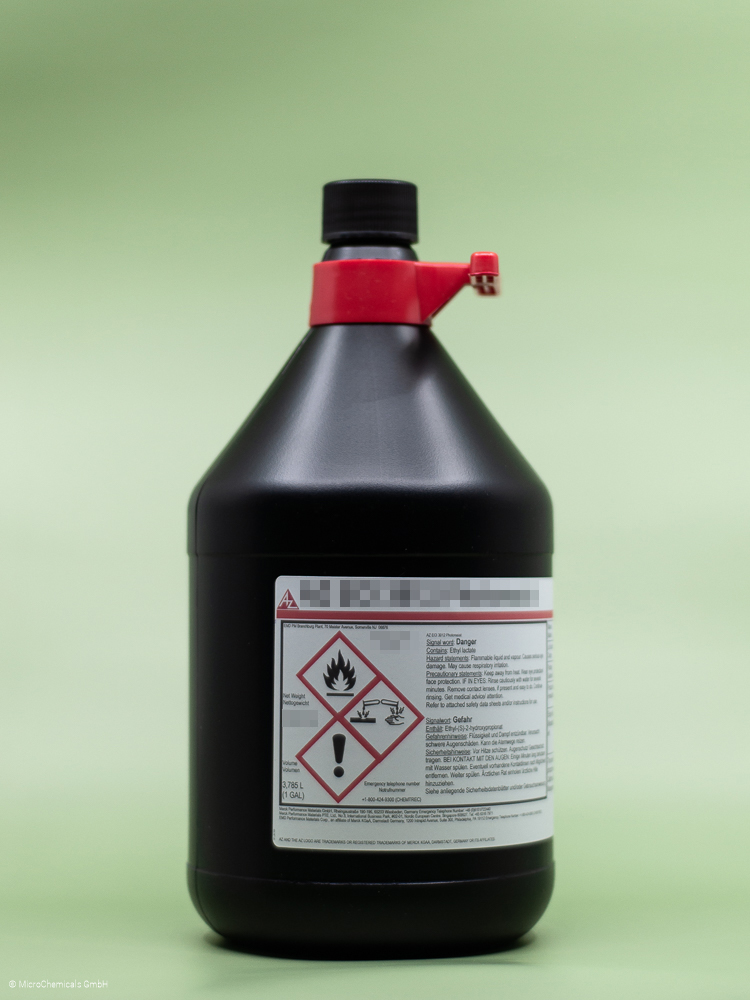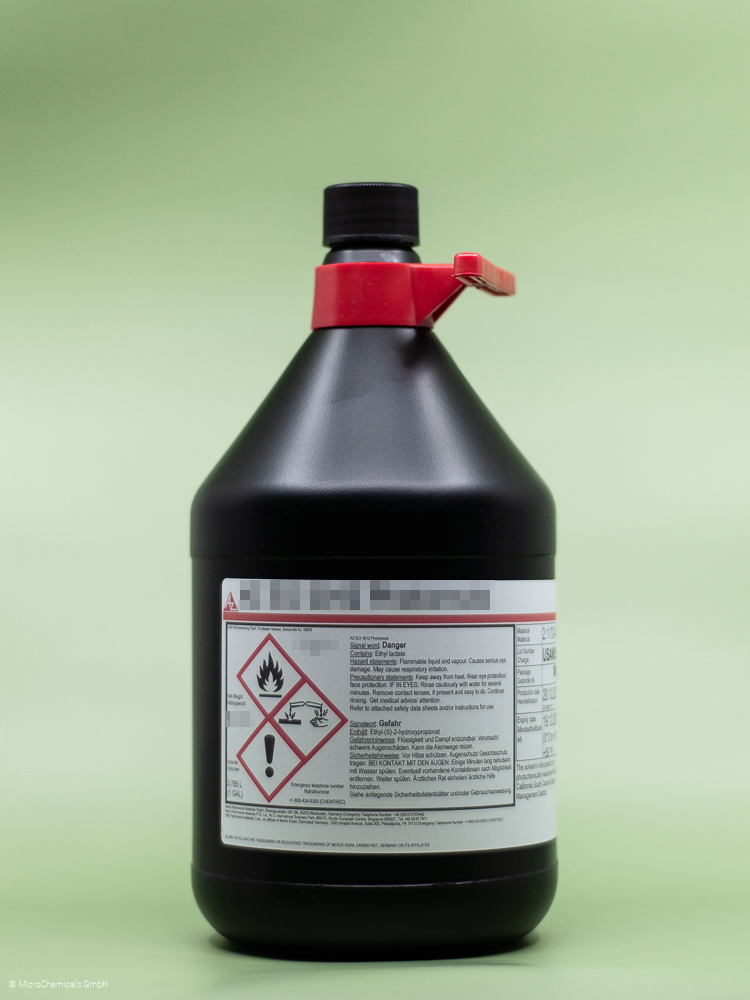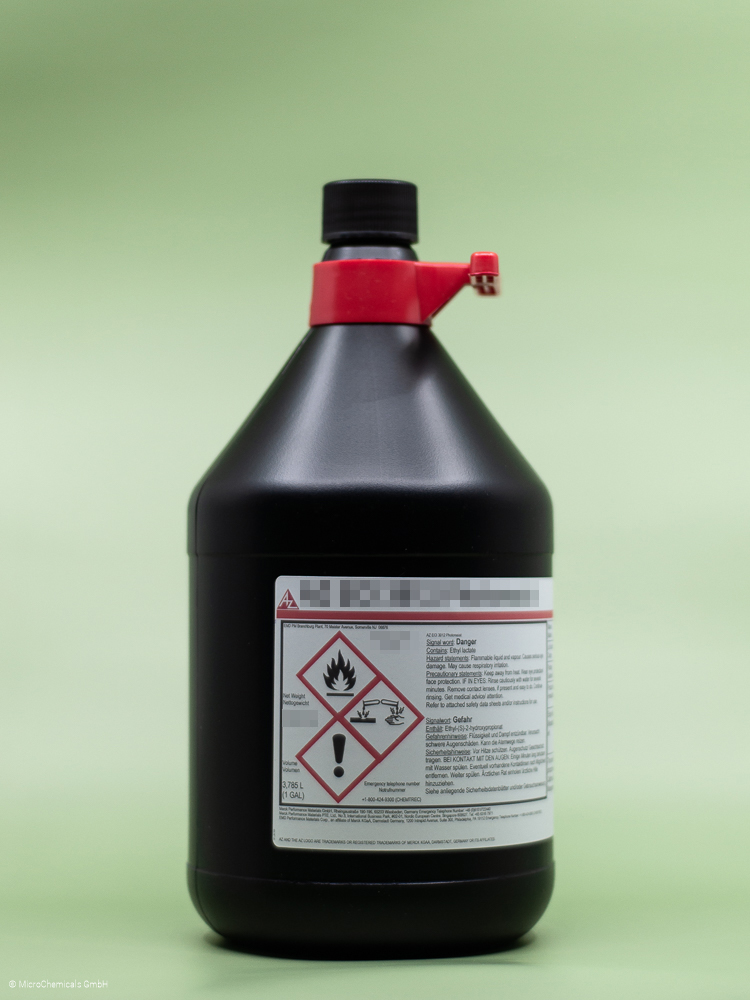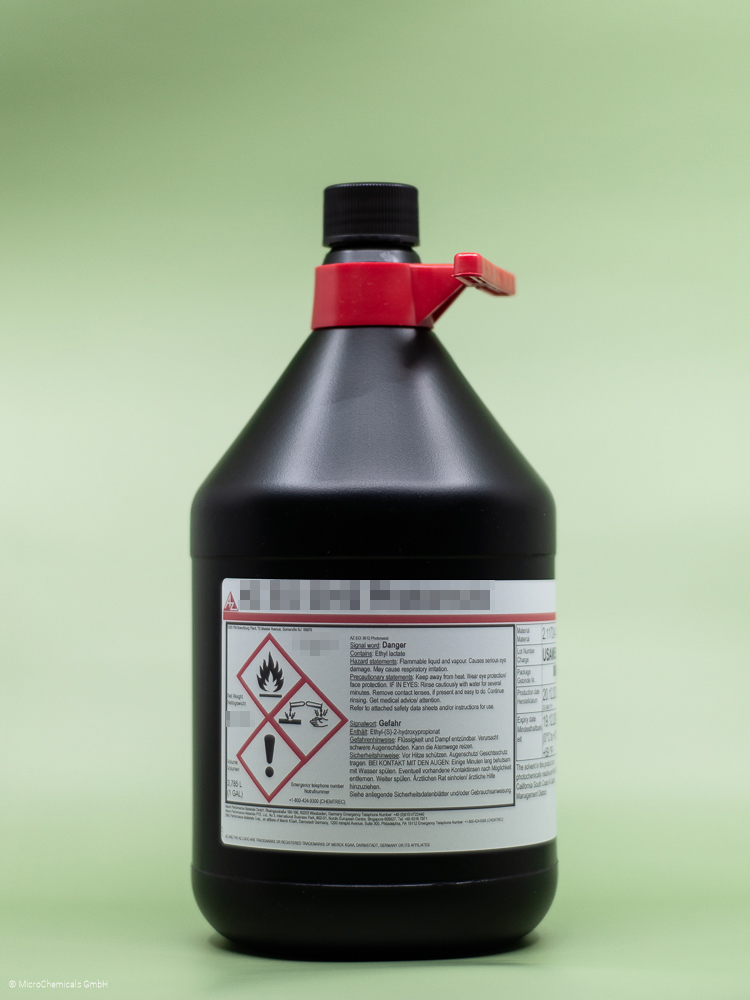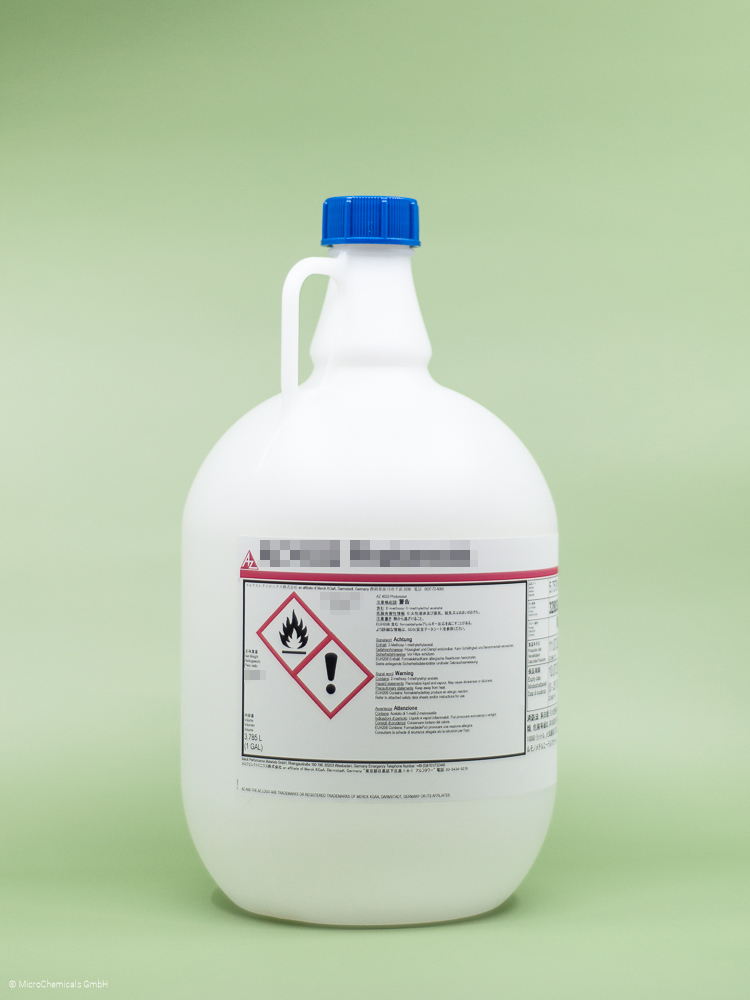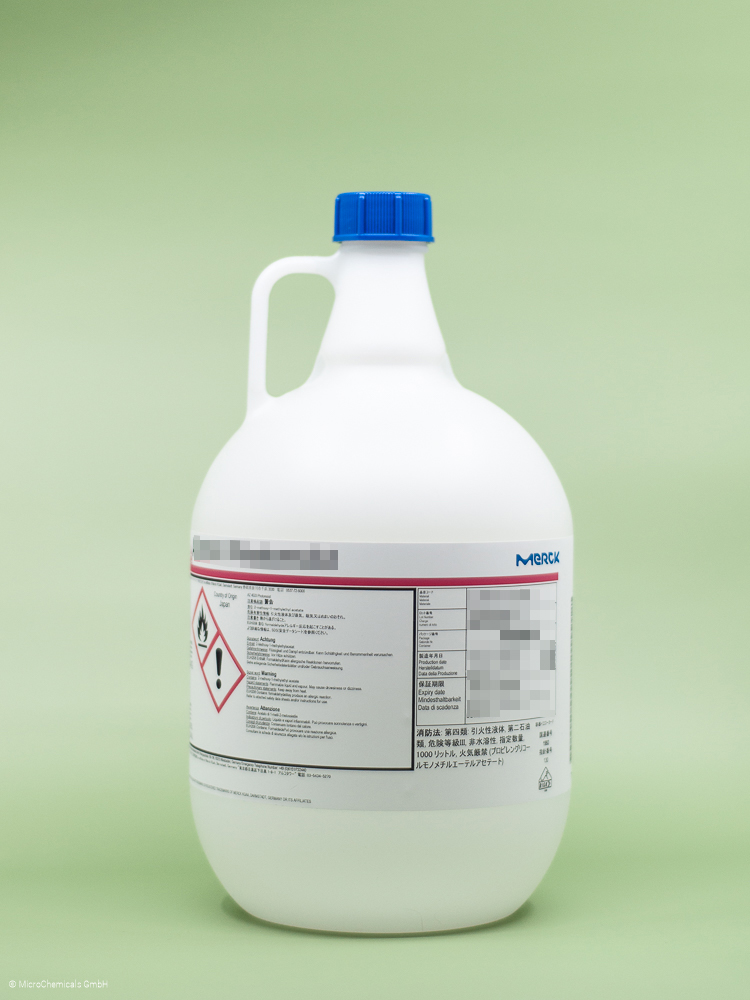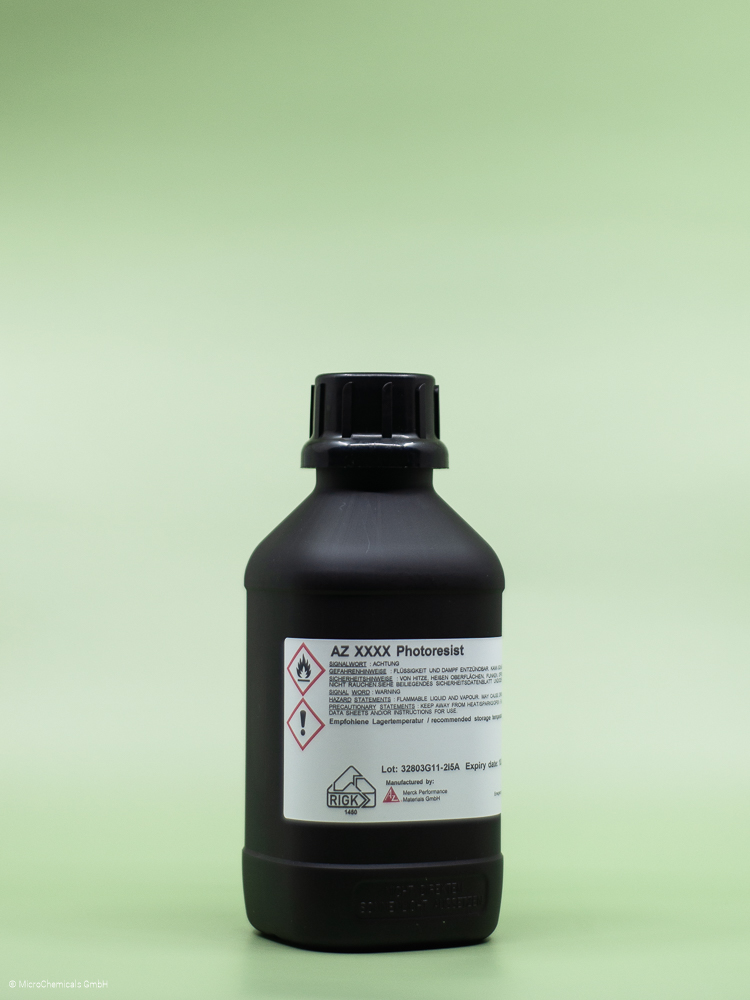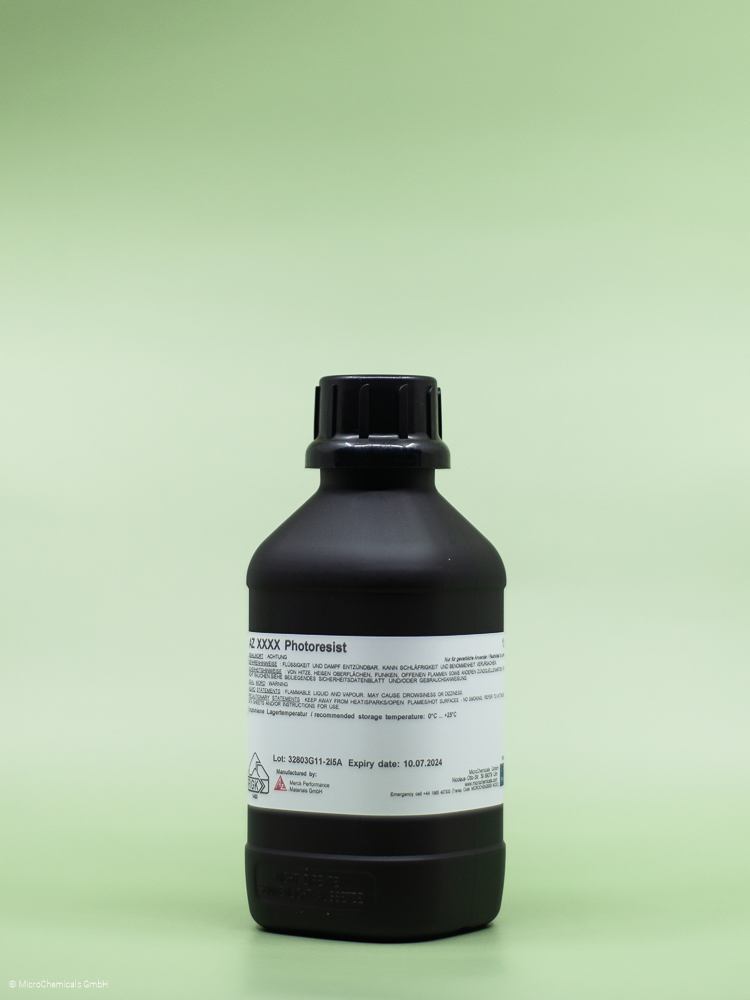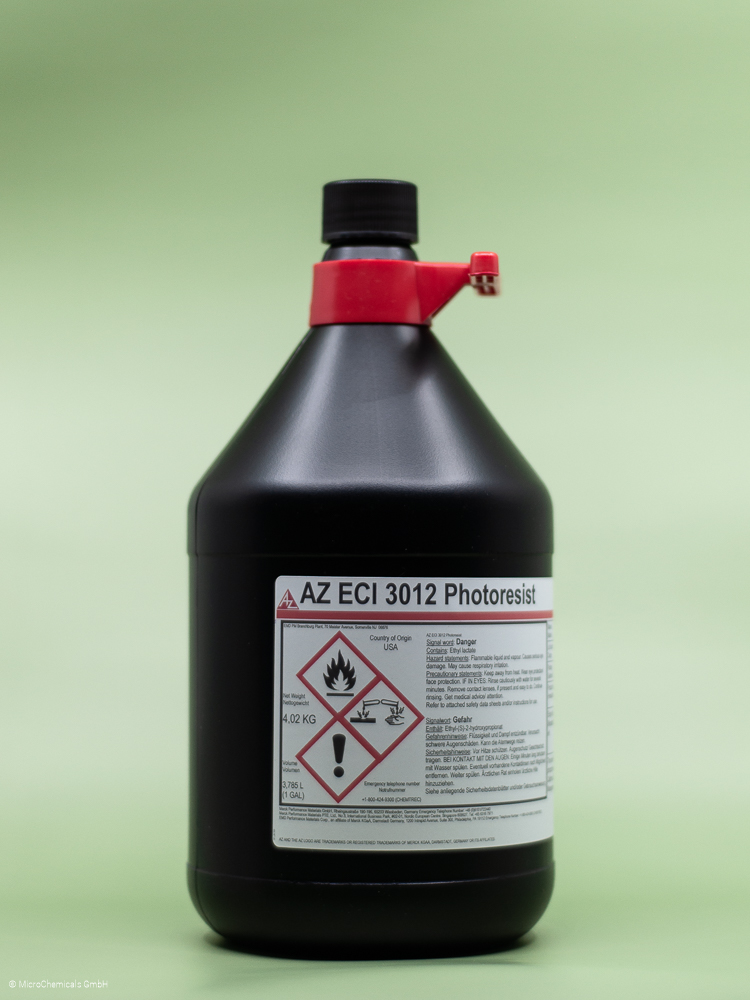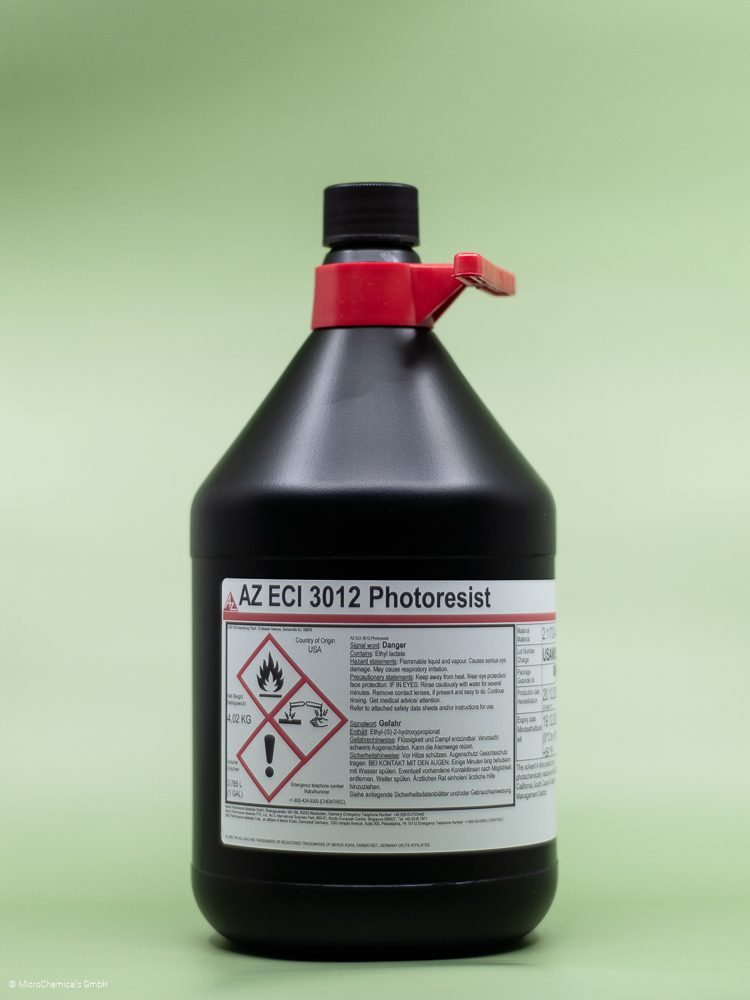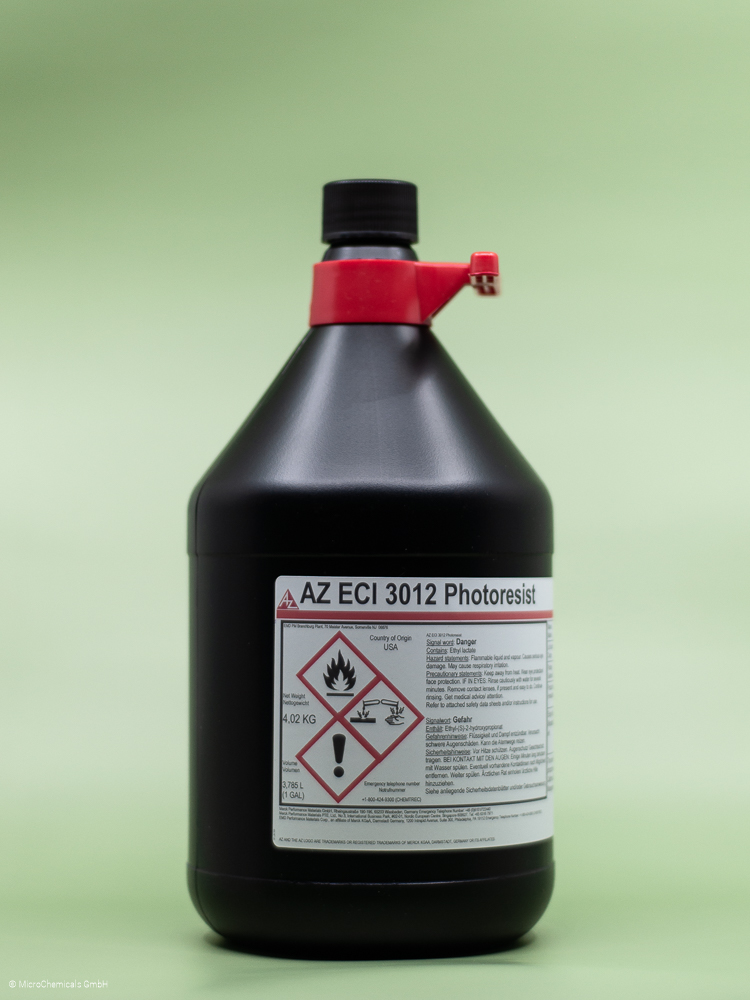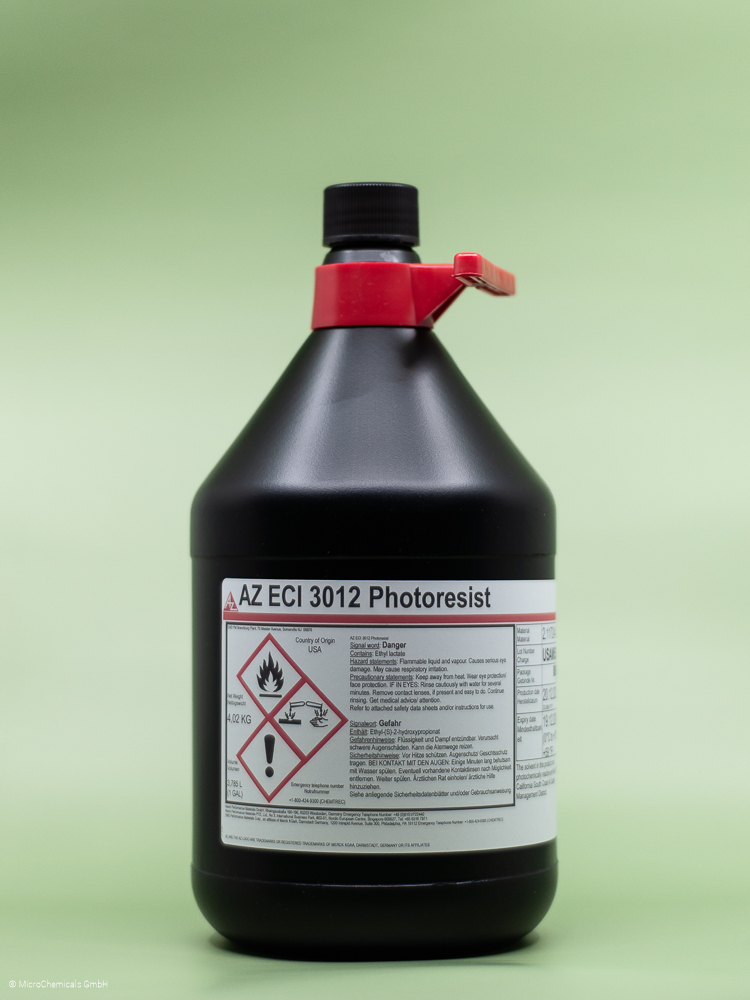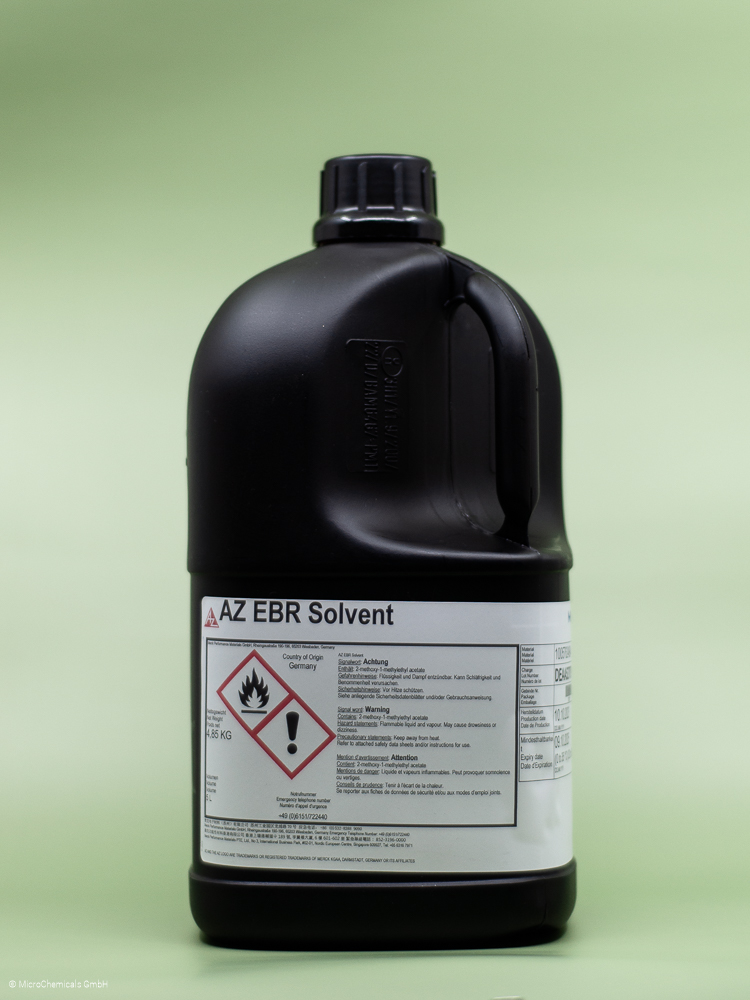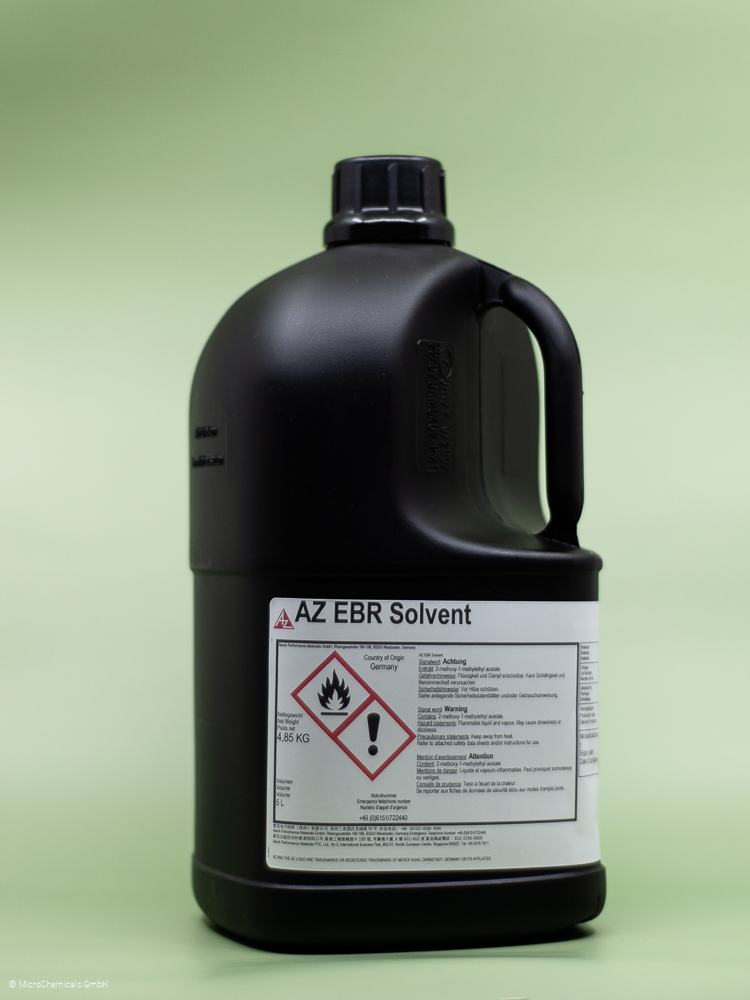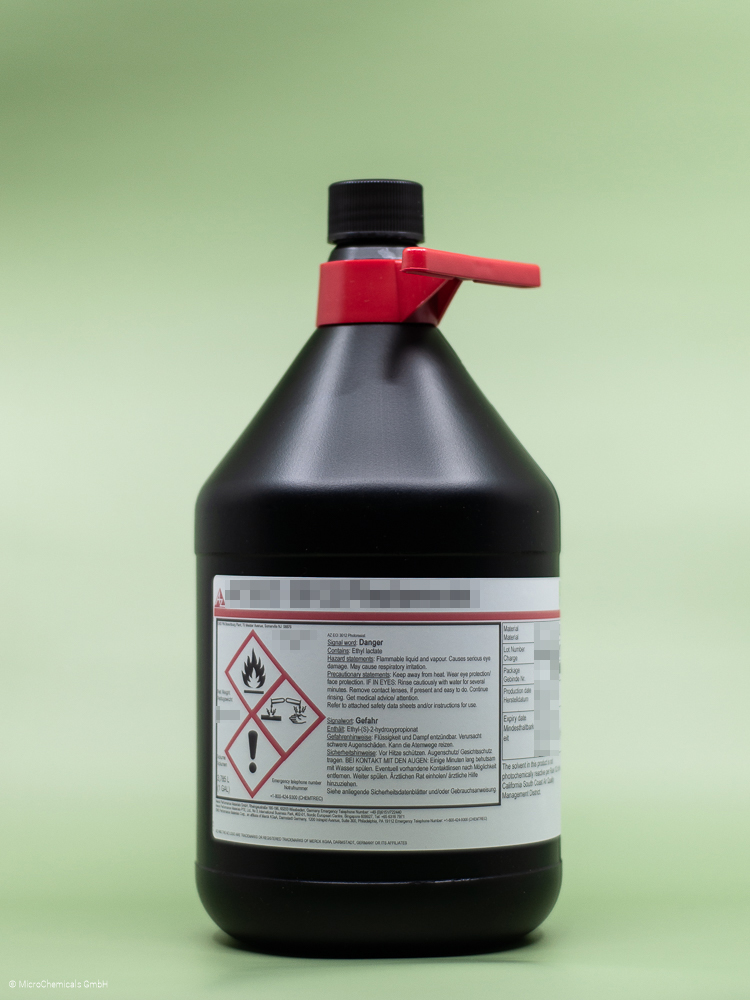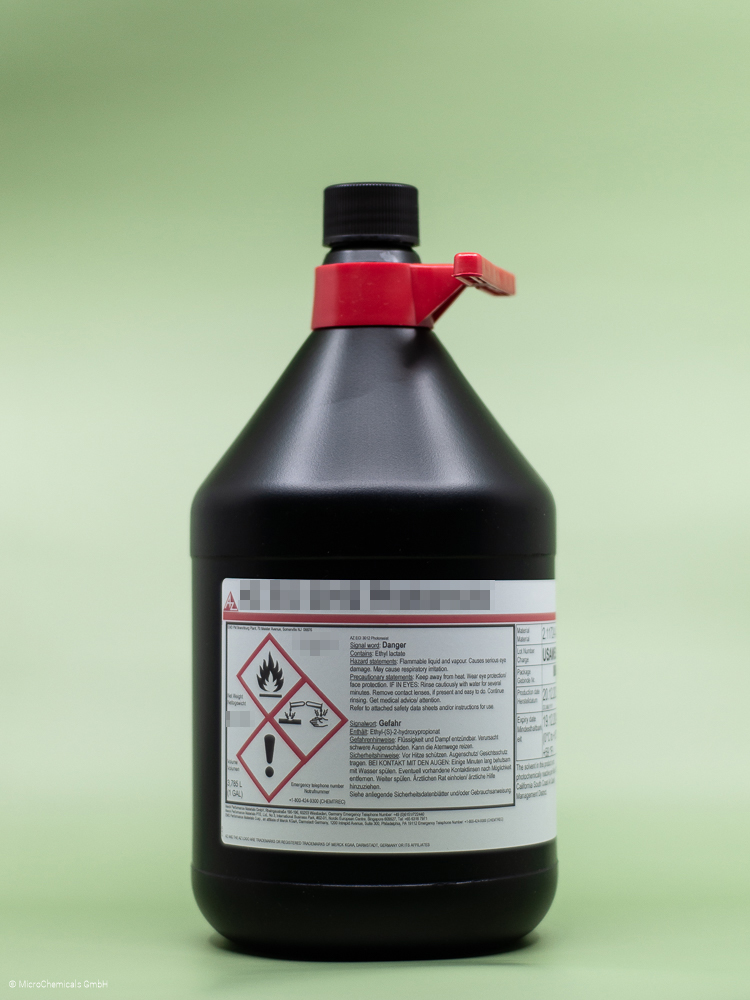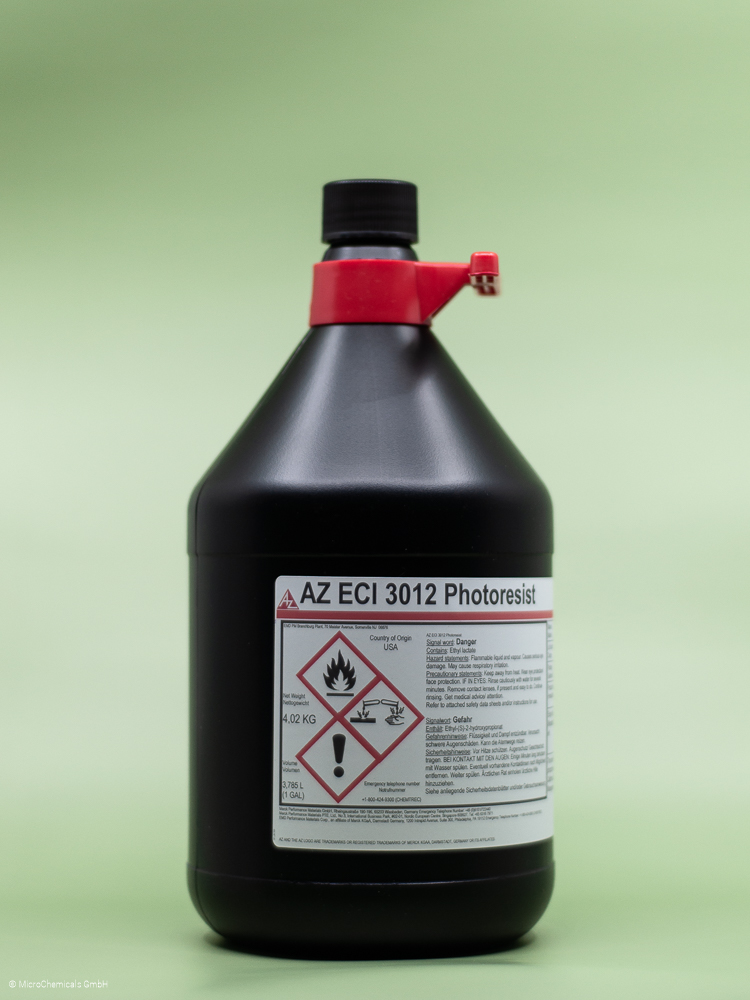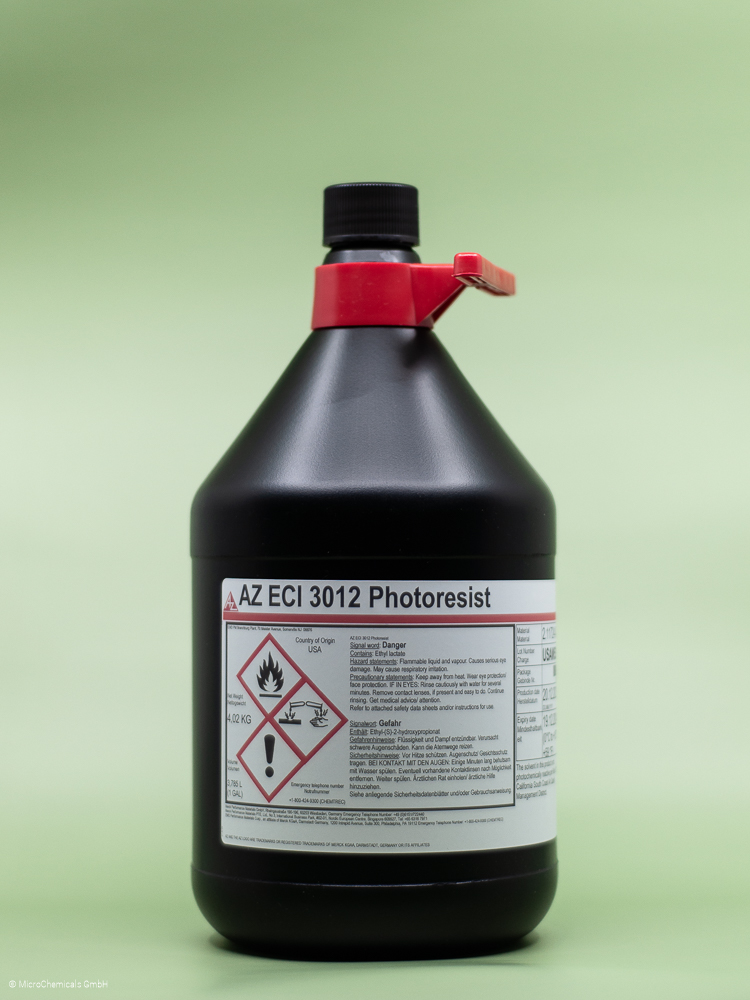NEGATIVE PHOTORESIST
Negative resists such as the AZ® nLOF 2000 series or AZ® 15 nXT and AZ® 125 nXT are cross-linked at the exposed areas and remain there on the substrate after development, while the non-exposed areas are cleared. The cross-linking prevents a thermal softening of the resist profiles.
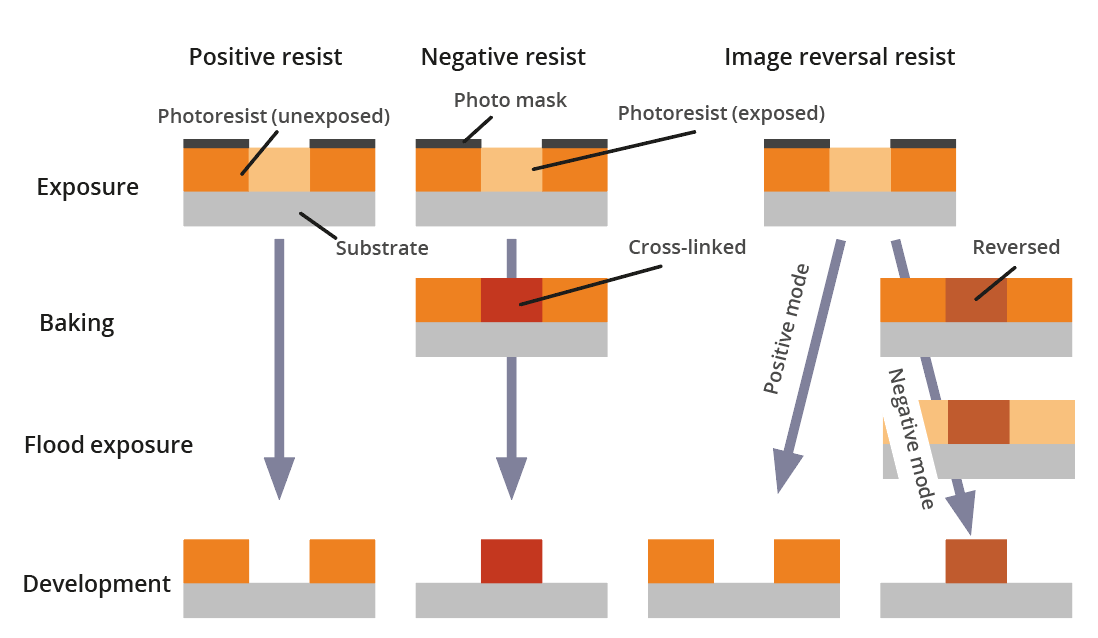
The schematic process sequence of the exposure (above) up to the
developed resist features (below) in the processing of positive resists
(left column), negative resists (centre) and image reversal resists
(right); the latter in two possible modes. The special features of the
attainable resist profiles are not included in this scheme.
Filter
–
AZ 125nXT-10B Photoresist - 3.785 l
1125nXT10B
Bottle size:
3.785 l
AZ® 125nXT-10B
Ultra-Thick Negative Resist for Plating
General Information
The AZ® 125nXT-10B is an i-line sensitive, negative ultra-thick resist with steep resist sidewalls and high aspect ratio.
20 µm lines at 60 µm resist film thickness.
15 µm holes at 60 µm resist film thickness.
80 µm plated CuNi image.
Product Features
The ultra-thick negative resist AZ® 125nXT-10B covers a resist film thickness range of 20 - 50 µm and can be built up and processed to 100 µm and much more with adapted spin profiles. AZ® 125nXT-10B is only i-line sensitive and, as a special feature (for negative resists), does not require a post exposure bake after exposure for cross-linking, i.e. the AZ® 125nXT-10B photopolymerizes. Due to its low absorption, even very thick resist layers can be easily exposed and steep resist sidewalls can be achieved. This and its very good adhesion to all common substrate materials make this resist suitable for the galvanic molding of thick to very thick layers as well as DRIE. With low exposure doses or very thick resist layers - related to the respective resist film thickness - the resist profile becomes slightly negative, since the resist areas close to the substrate experience less cross-linking. If the electroplating process shows that these weakly cross-linked areas of the resist are attacked, but a higher structuring exposure dose is not an option, flood exposure (without a photomask) after development with very high doses can cross-link the resist sidewalls even near the substrate, which, however, makes it more difficult to strip the resist later. Even after such flood exposure, no further post exposure back is necessary. AZ® 125nXT-10B can generally be processed with resist films of less than 20 µm thick, but processing becomes problematic below 10 µm thickness: Since the additive responsible for cross-linking escapes from the resist surface during softbaking, only a few micrometers of the exposed resist surface are removed during development, which accounts for a correspondingly large proportion of the total thickness in the case of thin resist films.
Developers
AZ® 326 MIF (immersion development), AZ® 726 MIF (puddle development) or AZ® 2026 MIF (which has an additive that promotes residue-free development, especially with cross-linking resists) are recommended for developing the AZ® 125nXT-10B. KOH- or NaOH-based developers such as AZ® 400K or AZ® 351B are generally not suitable for the AZ® 125nXT-10B. If TMAH-based developers cannot be used, a KOH-based developer in higher concentration than usual can be considered.
Removers
AZ® 125nXT-10B can be removed wet-chemically using conventional strippers, but stripping very thick cross-linked resist structures can be quite a challenge. If organic solvents are preferred for this, (hot) DMSO is recommended, which does not dissolve cross-linked resists, but can detach them from the substrate after a certain exposure time. This process can be accelerated by reducing the degree of cross-linking of the resist near the substrate by using a lower exposure dose. Alternatively, high-performance strippers such as the NMP-free TechniStrip P1316 are recommended, or in the case of alkaline-sensitive substrate materials (such as aluminum), the TechniStrip MLO 07.
Thinning/ Edge Wall Removal
If the resist is to be diluted for spin coating, PGMEA = AZ® EBR Solvent is an option. PGMEA is the solvent for AZ® 125nXT-10B anyway and is also recommended for edge wall removal if necessary.
Further Information
Our safety data sheets and some of our technical data sheets are password-protected.
You will receive the access data after completing the form.
The access data for the data sheets are not your login data from our shop!
MSDS:
Safety Data Sheet AZ® 125nXT-10B english
Safety Data Sheet AZ® 125nXT-10B german
TDS:
Technical Data Sheet AZ® 125nXT-10B english
Application Notes:
Further Information about Photoresist Processing
AZ 15nXT Photoresist (115cps) - 3.785 l
15nXT1153
Bottle size:
3.785 l
AZ® 15nXT (115CPS)
Thick Negative Resist for Plating
General Information
The i-line sensitive negative resist AZ® 15nXT (115CPS) is a thick resist with approx. 3 - 5 µm film thickness and very steep resist sidewalls for e. g. RIE or electroplating, for example.
5 µm lines at 10 µm resist film thickness.
5 µm holes at 10 µm resist film thickness.
5 µm plated CuNi image.
3.6 µm plated CuNi image.
Product Features
AZ® 15nXT (115CPS) covers a resist film thickness range of - depending on the spin speed - approx. 2 - 3 µm. It is only i-line sensitive and requires a post exposure bake after exposure to complete the cross-linking induced during exposure. The resist structures developed are very vertical with adjusted process parameters, becoming increasingly negative towards thick resist films or - based on the respective resist film thickness - lower exposure doses. If thinner resist films are required, the AZ® 15nXT (115CPS) can be diluted with PGMEA = AZ® EBR Solvent; for thicker layers, the higher viscosity AZ® 15nXT (450CPS) is recommended. AZ® 15nXT (115CPS) is suitable as a mask for the galvanic deposition of e.g. Cu, Ni or Au due to its good adhesion to all common substrate materials and its high chemical stability.
Developers
For the development of the AZ® 15nXT (115CPS), TMAH-based developers such as the ready-to-use AZ® 326 MIF (immersion development), AZ® 726 MIF (puddle development) or AZ® 2026 MIF are recommended, which promotes residue-free development, especially with cross-linking resists, thanks to an additive. KOH- or NaOH-based developers such as the AZ® 400 K or AZ® 351B are generally not suitable for the AZ® 15nXT (115CPS). If TMAH-based developers cannot be used, an attempt with a KOH-based developer in higher concentration than usual can be considered.
Removers
If the resist structures have not been thermally cross-linked too much, for example through metallization, stripping or lift-off with organic solvents (acetone rinsed with isopropanol or DMSO) can be successful. For more strongly cross-linked resist structures, high-performance strippers such as the NMP-free TechniStrip NI555 or AZ® 910 Remover are recommended, or in the case of alkaline-sensitive substrate materials (such as aluminum), the TechniStrip MLO 07.
Thinning/ Edge Wall Removal
If the resist is to be diluted for spin coating, PGMEA = AZ® EBR Solvent is an option. PGMEA is the solvent for AZ® 15nXT (115CPS) anyway and is also recommended for edge wall removal if necessary.
Further Information
Our safety data sheets and some of our technical data sheets are password-protected.
You will receive the access data after completing the form.
The access data for the data sheets are not your login data from our shop!
MSDS:
Safety Data Sheet AZ® 15nXT (115CPS) Photoresist english
Safety Data Sheet AZ® 15nXT (115CPS) Photoresist german
TDS:
Technical Data Sheet AZ® 15nXT (115CPS) Photoresist english
Technical Data Sheet AZ® 15nXT Series english
Application Notes:
Further Information about Photoresist Processing
AZ 15nXT Photoresist (450cps) - 3.785 l
15nXT3
Bottle size:
3.785 l
AZ® 15nXT (450CPS)
Thick Negative Resist for Plating
General Information
The i-line sensitive negative resist AZ® 15nXT (450CPS) is a thick resist with a thickness of approx. 5 - 10 µm and vertical resist sidewalls for RIE or electroplating, for example.
5 µm lines at 10 µm resist film thickness.
5 µm holes at 10 µm resist film thickness.
5 µm plated CuNi image.
3.6 µm plated CuNi image.
Product Features
AZ® 15nXT (450CPS) covers a resist film thickness range of - depending on the spin speed - approx. 5 - 10 µm. It is only i-line sensitive and requires a post exposure bake after exposure to complete the cross-linking induced during exposure. With adjusted process parameters, the resist structures developed are vertical, increasingly negative towards thick resist films or - based on the respective resist film thickness - lower exposure doses. If thinner resist films are required, the AZ® 15nXT (450CPS) can be diluted with PGMEA = AZ® EBR Solvent. AZ® 15nXT (450CPS) is suitable as a mask for the galvanic deposition of e.g. Cu, Ni or Au due to its good adhesion to all common substrate materials and its high chemical stability.
Developers
For the development of the AZ® 15nXT (450CPS), TMAH-based developers such as the ready-to-use AZ® 326 MIF (immersion development), AZ® 726 MIF (puddle development) or AZ® 2026 MIF are recommended, which promotes residue-free development, especially with cross-linking resists, thanks to an additive. KOH- or NaOH-based developers such as the AZ® 400 K or AZ® 351B are generally not suitable for the AZ® 15nXT (450CPS). If TMAH-based developers cannot be used, an attempt with a KOH-based developer in higher concentration than usual can be considered.
Removers
If the resist structures have not been thermally cross-linked too much, for example through metallization, stripping or lift-off with organic solvents (acetone rinsed with isopropanol or DMSO) can be successful. For more strongly cross-linked resist structures, high-performance strippers such as the NMP-free TechniStrip NI555 or AZ® 910 Remover are recommended, or in the case of alkaline-sensitive substrate materials (such as aluminum), the TechniStrip MLO 07.
Thinning/ Edge Wall Removal
If the resist is to be diluted for spin coating, PGMEA = AZ® EBR Solvent is an option. PGMEA is the solvent for AZ® 15nXT (450CPS) anyway and is also recommended for edge wall removal if necessary.
Further Information
Our safety data sheets and some of our technical data sheets are password-protected.
You will receive the access data after completing the form.
The access data for the data sheets are not your login data from our shop!
MSDS:
Safety Data Sheet AZ® 15nXT (450CPS) Photoresist english
Safety Data Sheet AZ® 15nXT (450CPS) Photoresist german
TDS:
Technical Data Sheet AZ® 15nXT (450CPS) Photoresist english
Technical Data Sheet AZ® 15nXT Series english
Information AZ® 15nXT (450CPS) Photoresist english
Application Notes:
Further Information about Photoresist Processing
AZ LNR-003 - 3.785 l
100LNR003
Bottle size:
3.785 l
AZ® LNR-003
Negative Resist for Lift-off Applications
General Information
The i-line sensitive negative resist AZ® LNR 003 with a resist film thickness of approx. 2 - 4 µm is a resist optimized primarily for lift-off applications due to its adjustable strong undercut.
Product Properties
AZ® LNR 003 covers a resist film thickness range of - depending on the spin speed - approx. 2 - 4 µm. It is only i-line sensitive and requires a post exposure bake after exposure to complete the cross-linking induced during exposure. The developed resist structures are, as desired for lift-off applications, pronounced negative even with low resist film thicknesses, since the strong absorption means that the upper resist areas receive a much higher dose during exposure and thus cross-link more strongly than the resist areas close to the substrate. The undercut can be adjusted over a relatively large range using the exposure dose (lower dose = stronger undercut) and the duration of overdevelopment. This also enables critical lift-off applications (for example sputtered or thicker layers) to be implemented. However, it should be noted that too strong an undercut can lead to narrow resist structures lifting off the substrate during development. If even thinner resist layers are required, the LNR 003 can be diluted with PGMEA = AZ® EBR Solvent, for which we offer an appropriately diluted version (AZ® LNR-003 diluted). For thicker layers > 3 µm resist thickness, the AZ® nLOF 2000 series is recommended.
Developers
AZ® 326 MIF (immersion development), AZ® 726 MIF (puddle development) or AZ® 2026 MIF (which has an additive that promotes residue-free development, especially with cross-linking resists) are recommended for developing the AZ® LNR 003. KOH- or NaOH-based developers such as AZ® 400K or AZ® 351B are generally not suitable for the AZ® LNR 003. If TMAH-based developers cannot be used, an attempt with a normal or more aggressive KOH-based developer can be considered.
Removers
If the resist structures have not been thermally cross-linked too much, for example through metallization, stripping or lift-off with organic solvents (acetone rinsed with isopropanol or DMSO) can be successful. For more strongly cross-linked resist structures, high-performance strippers such as the NMP-free TechniStrip NI555 or AZ® 920 Remover are recommended, or in the case of alkaline-sensitive substrate materials (such as aluminum), the TechniStrip MLO 07.
Thinning/ Edge Bead Removal
If the resist is to be diluted for spin coating, PGMEA = AZ® EBR Solventis an option. PGMEA is the solvent for AZ® LNR 003 anyway and is also recommended for edge removal if necessary.
Further Information
Our safety data sheets and some of our technical data sheets are password-protected.
You will receive the access data after completing the form.
The access data for the data sheets are not your login data from our shop!
MSDS:
Safety Data Sheet AZ® LNR-003 Photoresist english
Safety Data Sheet AZ® LNR-003 Photoresist german
TDS:
Technical Data Sheet AZ® LNR-003 english
Information AZ® LNR-003 english
Application Notes:
Further Information about Photoresist Processing
AZ LNR-003 diluted - 1:0.3 with PGMEA - 1.00 l
1LNR00313P01
Bottle size:
1.00 l
AZ® LNR-003 diluted – 1:0.3 with PGMEA
Negative Resist for Lift-off Applications
General Information
The i-line sensitive negative resist AZ® LNR 003 with a resist film thickness of approx. 1 - 2 µm is a resist optimized primarily for lift-off applications due to its adjustable strong undercut.
Product Properties
AZ® LNR 003 covers a resist film thickness range of - depending on the spin speed - approx. 1 - 2 µm. It is only i-line sensitive and requires a post exposure bake after exposure to complete the cross-linking induced during exposure. The developed resist structures are, as desired for lift-off applications, pronounced negative even with low resist film thicknesses, since the strong absorption means that the upper resist areas receive a much higher dose during exposure and thus cross-link more strongly than the resist areas close to the substrate. The undercut can be adjusted over a relatively large range using the exposure dose (lower dose = stronger undercut) and the duration of overdevelopment. This also enables critical lift-off applications (for example sputtered or thicker layers) to be implemented. However, it should be noted that too strong an undercut can lead to narrow resist structures lifting off the substrate during development. If even thinner resist layers are required, the AZ® LNR 003 can be diluted with PGMEA = AZ® EBR Solvent, whereby it becomes increasingly difficult to achieve an undercut with based resist layers. For thicker resist layers, the higher viscosity version of the AZ® LNR 003 is recommended or for > 3 µm resist film thickness the AZ® nLOF 2000 series.
Developers
TMAH-based developers such as the ready-to-use AZ® 326 MIF (immersion development), AZ® 726 MIF (puddle development) or AZ® 2026 MIF (which has an additive that promotes residue-free development, especially with cross-linking resists) are recommended for developing the AZ® LNR 003. KOH- or NaOH-based developers such as AZ® 400K or AZ® 351B are generally not suitable for the AZ® LNR 003. If TMAH-based developers cannot be used, an attempt with a normal or more aggressive KOH-based developer can be considered.
Removers
If the resist structures have not been thermally cross-linked too much, for example through metallization, stripping or lift-off with organic solvents (acetone rinsed with isopropanol or DMSO) can be successful. For more strongly cross-linked resist structures, high-performance strippers such as the NMP-free TechniStrip NI555 or AZ® 920 Remover are recommended, or in the case of alkaline-sensitive substrate materials (such as aluminum), the TechniStrip MLO 07.
Thinning/ Edge Bead Removal
If the resist is to be diluted for spin coating, PGMEA = AZ® EBR Solventis an option. PGMEA is the solvent for AZ® LNR 003 anyway and is also recommended for edge removal if necessary.
Further Information
Our safety data sheets and some of our technical data sheets are password-protected.
You will receive the access data after completing the form.
The access data for the data sheets are not your login data from our shop!
MSDS:
Safety Data Sheet AZ® LNR-003 Photoresist english
Safety Data Sheet AZ® LNR-003 Photoresist german
TDS:
Technical Data Sheet AZ® LNR-003 english
Information AZ® LNR-003 english
Application Notes:
Further Information about Photoresist Processing
AZ NLOF 2020 Photoresist - 3.785 l
1A002020
Bottle size:
3.785 l
AZ® nLOF 2020
Thick Negative Resist for Lift Off
General Information
The i-line sensitive negative resist AZ® nLOF 2020 is, with a resist film thickness of approx. 2 µm, the thinnest member of the AZ® nLOF 2000 series, which is primarily optimized for lift-off applications.
700 nm resist lines attained with the 2.0 µm thick AZ® nLOF 2020.
Product Properties
AZ® nLOF 2020 covers a resist film thickness range of - depending on the spin speed - approx. 1.5 - 2.5 µm. It is only i-line sensitive and requires a post exposure bake after exposure to complete the cross-linking induced during exposure. The developed resist structures are (slightly) negative, as desired for lift-off applications, because the upper resist areas receive a slightly higher dose during exposure and thus cross-link more strongly than the resist areas close to the substrate. This undercut can only be increased to a limited extent using a lower exposure dose, because the low resist film thickness is in the range of the penetration depth of the exposure wavelength, meaning that even with low exposure doses it is always exposed through to the substrate. If even thinner resist layers are desired, the AZ® nLOF 2020 can be diluted with PGMEA = AZ® EBR Solvent or the use of AZ® LNR-003 can be considered. For thicker layers, we recommend the AZ® nLOF 2035 (approx. 3 - 4 µm) or the even thicker AZ® nLOF 2070 (> 5 µm), both of which differ from the AZ® nLOF 2020 only in the solvent content.
Developers
TMAH-based developers such as the ready-to-use AZ® 326 MIF (immersion development), AZ® 726 MIF (puddle development) or AZ® 2026 MIF (which uses an additive to promote residue-free development, especially with cross-linking resists) are recommended for developing the AZ® nLOF 2020. KOH- or NaOH-based developers such as the AZ® 400K or AZ® 351Bare generally not suitable for the AZ® nLOF 2020. If TMAH-based developers cannot be used, an attempt with a KOH-based developer in higher concentration than usual can be considered.
Removers
If the resist structures have not been thermally cross-linked too much, for example through metallization, stripping or lift-off with organic solvents (acetone rinsed with isopropanol or DMSO) can be successful. For more strongly cross-linked resist structures, high-performance strippers such as the NMP-free TechniStrip NI555 or AZ® 920 Remover are recommended, or in the case of alkaline-sensitive substrate materials (such as aluminum), the TechniStrip MLO 07.
Thinning/ Edge Bead Removal
If the resist is to be diluted for spin coating, PGMEA = AZ® EBR Solvent is an option. PGMEA is the solvent for AZ® nLOF 2020 anyway and is also recommended for edge wall removal if necessary.
Further Information
Our safety data sheets and some of our technical data sheets are password-protected.
You will receive the access data after completing the form.
The access data for the data sheets are not your login data from our shop!
MSDS:
Safety Data Sheet AZ® nLOF2020 Photoresist english
Safety Data Sheet AZ® nLOF2020 Photoresist german
TDS:
Technical Data Sheet AZ® nLOF2000 Series english
Information AZ® nLOF2000 Series english
Information AZ® nLOF2000 Series german
Application Notes:
Further Information about Photoresist Processing
AZ NLOF 2035 Photoresist - 3.785 l
1A002035
Bottle size:
3.785 l
AZ® nLOF 2035
Thick Negative Resist for Lift Off
General Information
The i-line sensitive negative resist AZ® nLOF 2035 with a resist film thickness of approx. 3 - 4 µm is a member of the AZ® nLOF 2000 series, which is primarily optimized for lift-off applications.
700 nm resist lines attained with the 3.5 µm thick AZ® nLOF 2035.
Product Properties
AZ® nLOF 2035 covers a resist film thickness range of - depending on the spin speed - approx. 3 - 4 µm. It is only i-line sensitive and requires a post exposure bake after exposure to complete the cross-linking induced during exposure. The developed resist structures are pronounced negative, as desired for lift-off applications, since the upper resist areas receive a higher dose during exposure and thus cross-link more strongly than the resist areas close to the substrate. Using a lower exposure dose, in conjunction with a slightly hotter post exposure bake, this undercut can be increased to a certain extent to enable even more critical lift-off applications. If thinner resist layers are desired, the AZ® nLOF 2035 can be diluted with PGMEA = AZ® EBR Solvent or the AZ® nLOF 2020 can be used. For thicker layers, the AZ® nLOF 2070 (> 5 µm) is recommended; both differ from the AZ® nLOF 2035 only in the solvent content.
Developers
TMAH-based developers such as the ready-to-use AZ® 326 MIF (immersion development), AZ® 726 MIF (puddle development) or AZ® 2026 MIF (which uses an additive to promote residue-free development, especially with cross-linking resists) are recommended for developing the AZ® nLOF 2035. KOH- or NaOH-based developers such as the AZ® 400K or AZ® 351B are generally not suitable for the AZ® nLOF 2035. If TMAH-based developers cannot be used, an attempt with a KOH-based developer in higher concentration than usual can be considered.
Removers
If the resist structures have not been thermally cross-linked too much, for example through metallization, stripping or lift-off with organic solvents (acetone rinsed with isopropanol or DMSO) can be successful. For more strongly cross-linked resist structures, high-performance strippers such as the NMP-free TechniStrip NI555 or AZ® 920 Remover are recommended, or in the case of alkaline-sensitive substrate materials (such as aluminum), the TechniStrip MLO 07.
Thinning/ Edge Bead Removal
If the resist is to be diluted for spin coating, PGMEA = AZ® EBR Solvent is an option. PGMEA is the solvent for AZ® nLOF 2035 anyway and is also recommended for edge wall removal if necessary.
Further Information
Our safety data sheets and some of our technical data sheets are password-protected.
You will receive the access data after completing the form.
The access data for the data sheets are not your login data from our shop!
MSDS:
Safety Data Sheet AZ® nLOF2035 Photoresist english
Safety Data Sheet AZ® nLOF2035 Photoresist german
TDS:
Technical Data Sheet AZ® nLOF2000 Series english
Information AZ® nLOF2000 Series english
Information AZ® nLOF2000 Series german
Application Notes:
Further Information about Photoresist Processing
AZ NLOF 2070 - diluted 1:1.33 - 0.5 µm-grade (e-beam) - 5.00 l
20705005
Bottle size:
5.00 l
AZ® nLOF 2070 - diluted 1:1.33 - 0.50 µm-grade (e-beam)
Thick Negative Resist for Lift Off
General Information
AZ® nLOF 2070 Photoresist for 5-15 µm Resist Film Thickness (i-line)
The AZ® nLOF 2000 series is optimised with undercut resist profiles and high resistance to thermal flow for lift-off applications. The three viscosity grades AZ® nLOF 2020 (2.0 µm resist layer thickness at 4000 rpm), AZ® nLOF 2035 (3.5 µm) and AZ® nLOF 2070 (7.0 µm) cover a large resist layer thickness range with a high possible aspect ratio. A post exposure bake is obligatory to carry out the cross-linking initiated during exposure.
Beside the resist types above, MicroChemicals dilutes the AZ® nLOF 2000 series to different thickness levels.
Product Properties
AZ® nLOF 2070 for film thickness 7.0 µm @ 3000 rpm
i-line sensitive (365 nm), not g- or h-line sensitive
Very high thermal stability: Almost no rounding of cross-linked resist patterns up to temperatures of 250°C and more.
High chemical stability: Dependant on process parameters, AZ® nLOF 2000 series is stable against many organic solvents as well as strong alkaline media (however, not stable against KOH Si-etches!).
The e-beam sensitivity of the AZ® nLOF 2000 series resists allows the combination of fast UV and high-resolution e-beam lithography. (Please contact us for further information!)
Reproducible undercut for excellent lift off results
High yield in industrial processes due to large process window
Developers
The recommended developer is the AZ® 2026 MIF which works best with AZ® nLof 2000 series. AZ® 326 MIF or AZ® 726 MIF are possible as well. KOH- or NaOH based developers or AZ® Developer will not give reasonable results. Only AZ® 303 Developer can be used in cases, where TMAH based developers are no option.
Removers
The recommended stripper for the AZ® nLOF 2000 series is the NMP-free TechniStrip NI555 or AZ® 910 Remover, which is compatible with all common (even alkaline sensitive) substrate materials and can even dissolve (not only peel from the substrate) cross-linked AZ® nLOF 2070 resist films.
Solvents such as NMP or the untoxic substitute DMSO are suited removers, if the resist film thickness and degree of crosslinking are not too high.
Generally, heating these removers up to 60 - 80°C, or/and ultrasonic treatment, might be required to fasten the resist removal in the case of very thick or strongly cross-linked resist films.
Thinning/ Edge Bead Removal
We recommend for thinning and edge bead removal the AZ® EBR Solvent or PGMEA. AZ® EBR Solvent 70/30 is possible as well for edge bead removal.
Further Information
MSDS:
Safety Data Sheet AZ® nLOF2070 Photoresist english
Sicherheitsdatenblatt AZ® nLOF2070 Fotolack german
TDS:
Technical Data Sheet AZ® nLOF2000 Series english
Information AZ® nLOF2000 Series english
Information AZ® nLOF2000 Series german
Information AZ® nLOF2070 E-beam english
Application Notes:
Further Information about Photoresist Processing
AZ NLOF 2070 Photoresist - 3.785 l
1A002070
Bottle size:
3.785 l
AZ® nLOF 2070
Thick Negative Resist for Lift Off
General Information
The i-line sensitive negative resist AZ® nLOF 2070 is with approx. 5 - 10 µm resist film thickness the thickest member of the AZ® nLOF 2000 series, which is primarily optimized for lift-off applications.
A pronounced undercut attained with the AZ® nLOF 2070 in a thickness of 22 µm.
Product Properties
AZ® nLOF 2070 covers a resist film thickness range of - depending on the spin speed - approx. 5 - 10 µm. It is only i-line sensitive and requires a post exposure bake after exposure to complete the cross-linking induced during exposure. The developed resist structures are, as desired for lift-off applications, distinctly negative, since the upper resist areas receive a much higher dose during exposure and thus cross-link more strongly than the resist areas close to the substrate. Using a lower exposure dose, in conjunction with a slightly hotter post exposure bake, this undercut can also be increased significantly to enable more critical lift-off applications (sputtered or thicker layers). If thinner resist layers are required, the AZ® nLOF 2070 can be diluted with PGMEA = AZ® EBR Solvent or the AZ® nLOF 2035 or even thinner AZ® nLOF 2020 can be used, both differing only in the solvent content.
Developers
TMAH-based developers such as the ready-to-use AZ® 326 MIF (immersion development), AZ® 726 MIF (puddle development) or AZ® 2026 MIF (which uses an additive to promote residue-free development, especially with cross-linking resists) are recommended for developing the AZ® nLOF 2070. KOH- or NaOH-based developers such as the AZ® 400K or AZ® 351B are generally not suitable for the AZ® nLOF 2070. If TMAH-based developers cannot be used, an attempt with a KOH-based developer in higher concentration than usual can be considered.
Removers
If the resist structures have not been thermally cross-linked too much, for example through metallization, stripping or lift-off with organic solvents (acetone rinsed with isopropanol or DMSO) can be successful. For more strongly cross-linked resist structures, high-performance strippers such as the NMP-free TechniStrip NI555 or AZ® 920 Remover are recommended, or in the case of alkaline-sensitive substrate materials (such as aluminum), the TechniStrip MLO 07.
Thinning/ Edge Bead Removal
If the resist is to be diluted for spin coating, PGMEA = AZ® EBR Solvent is an option. PGMEA is the solvent for AZ® nLOF 2070 anyway and is also recommended for edge wall removal if necessary.
Further Information
Our safety data sheets and some of our technical data sheets are password-protected.
You will receive the access data after completing the form.
The access data for the data sheets are not your login data from our shop!
MSDS:
Safety Data Sheet AZ® nLOF2070 Photoresist english
Safety Data Sheet AZ® nLOF2070 Photoresist german
TDS:
Technical Data Sheet AZ® nLOF2000 Series english
Information AZ® nLOF2000 Series english
Information AZ® nLOF2000 Series german
Application Notes:
Further Information about Photoresist Processing
AZ NLOF 5510 Photoresist - 3.785 l
1055100
AZ® nLOF 5510
Thermally Stable Negative Resist
General Information
The AZ® nLOF 5510 is a thin, high-resolution negative resist with high thermal stability. This resist is designed for single layer lift off processes as well as for RIE etching or ion implantation and is compatible with TMAH-based developers.
Product Properties
AZ® nLOF 5510 for film thickness 0.8 µm @ 4000 rpm
i-line sensitive (365 nm), not g- or h-line sensitive
Very high thermal stability: Almost no rounding of cross-linked resist patterns up to temperatures of 250°C and more
Resolution down to 0.25 µm
Can be used for lift off, RIE or implant applications
Developers
Common TMAH based developers are recommended such as AZ® 326 MIF, AZ® 726 MIF or AZ® 2026 MIF Developer.
Removers
The recommended stripper for the AZ® nLOF 5510 resist is the NMP-free TechniStrip NI555 or AZ® 910 Remover, which is compatible with all common (even alkaline sensitive) substrate materials and can even dissolve (not only peel from the substrate) cross-linked AZ® nLOF 5510 resist films.
Solvents such as NMP or the untoxic substitute DMSO are suited removers, if the resist film thickness and degree of crosslinking are not too high.
Generally, heating these removers up to 60 - 80°C, or/and ultrasonic treatment, might be required to fasten the resist removal in the case of very thick or strongly cross-linked resist films.
Thinning/ Edge Bead Removal
We recommend for thinning and edge bead removal the AZ® EBR Solvent or PGMEA. AZ® EBR Solvent 70/30 is possible as well for edge bead removal.
Further Information
MSDS:
Safety Data Sheet AZ® nLOF5510 Photoresist english
Sicherheitsdatenblatt AZ® nLOF5510 Fotolack german
TDS:
Technical Data Sheet AZ® nLOF5510 english
Information AZ® nLOF2000 Series english
Information AZ® nLOF2000 Series german
Application Notes:
Further Information about Photoresist Processing
